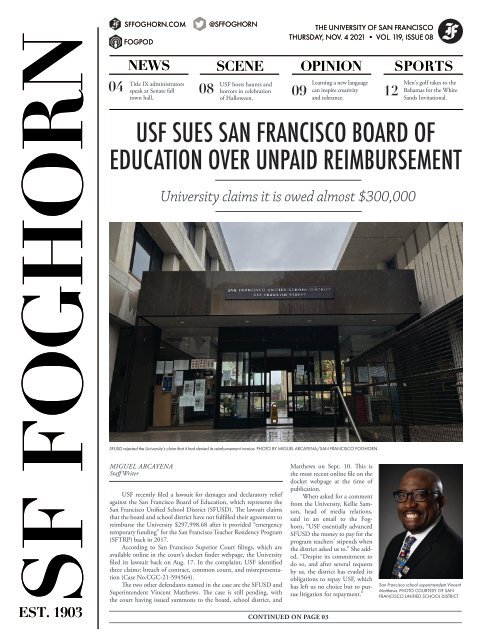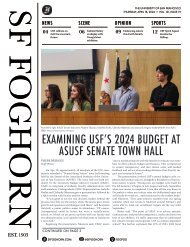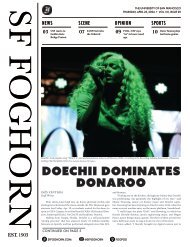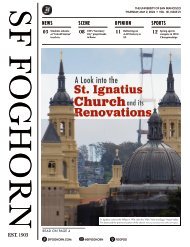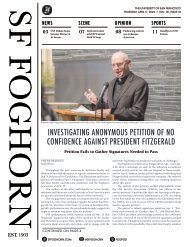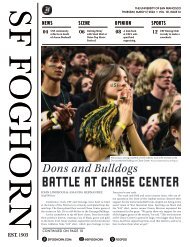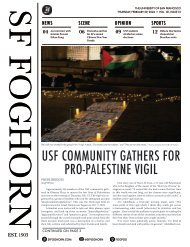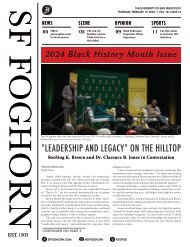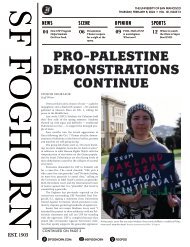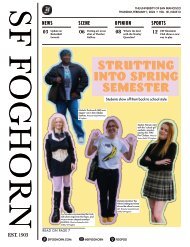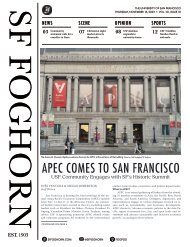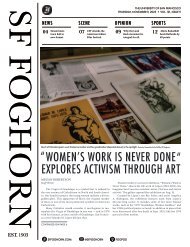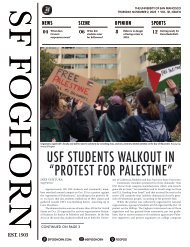Create successful ePaper yourself
Turn your PDF publications into a flip-book with our unique Google optimized e-Paper software.
SF FOGHORN<br />
EST. 1903<br />
04<br />
SFFOGHORN.COM<br />
FOGPOD<br />
NEWS<br />
Title IX administrators<br />
speak at Senate fall<br />
town hall.<br />
@SFFOGHORN<br />
THE UNIVERSITY OF SAN FRANCISCO<br />
THURSDAY, NOV. 4 <strong>2021</strong> • <strong>VOL</strong>. <strong>119</strong>, ISSUE 08<br />
SCENE OPINION SPORTS<br />
USF hosts haunts and<br />
Learning a new language<br />
08 horrors in celebration 09 can inspire creativity 12<br />
of Halloween.<br />
and tolerance.<br />
Men's golf takes to the<br />
Bahamas for the White<br />
Sands Invitational.<br />
USF SUES SAN FRANCISCO BOARD OF<br />
EDUCATION OVER UNPAID REIMBURSEMENT<br />
MIGUEL ARCAYENA<br />
Staff Writer<br />
University claims it is owed almost $300,000<br />
SFUSD rejected the University’s claim that it had denied its reimbursement invoice. PHOTO BY MIGUEL ARCAYENA/SAN FRANCISCO FOGHORN<br />
USF recently filed a lawsuit for damages and declaratory relief<br />
against the San Francisco Board of Education, which represents the<br />
San Francisco Unified School District (SFUSD). The lawsuit claims<br />
that the board and school district have not fulfilled their agreement to<br />
reimburse the University $297,998.68 after it provided “emergency<br />
temporary funding” for the San Francisco Teacher Residency Program<br />
(SFTRP) back in 2017.<br />
According to San Francisco Superior Court filings, which are<br />
available online in the court’s docket finder webpage, the University<br />
filed its lawsuit back on Aug. 17. In the complaint, USF identified<br />
three claims: breach of contract, common count, and misrepresentation<br />
(Case No.CGC-21-594564).<br />
The two other defendants named in the case are the SFUSD and<br />
Superintendent Vincent Matthews. The case is still pending, with<br />
the court having issued summons to the board, school district, and<br />
CONTINUED ON PAGE 03<br />
Matthews on Sept. 10. This is<br />
the most recent online file on the<br />
docket webpage at the time of<br />
publication.<br />
When asked for a comment<br />
from the University, Kellie Samson,<br />
head of media relations,<br />
said in an email to the Foghorn,<br />
“USF essentially advanced<br />
SFUSD the money to pay for the<br />
program teachers' stipends when<br />
the district asked us to.” She added,<br />
“Despite its commitment to<br />
do so, and after several requests<br />
by us, the district has evaded its<br />
obligations to repay USF, which<br />
has left us no choice but to pursue<br />
litigation for repayment.”<br />
San Francisco school superintendent Vincent<br />
Matthews. PHOTO COURTESY OF SAN<br />
FRANCISCO UNIFIED SCHOOL DISTRICT
02<br />
THURSDAY<br />
NOV. 01<br />
<strong>2021</strong><br />
STAFF<br />
SUBMISSION POLICY<br />
The San Francisco Foghorn is the<br />
official student newspaper of the<br />
University of San Francisco and is<br />
sponsored by the Associated Students<br />
of the University of San Francisco<br />
(ASUSF).<br />
The thoughts and opinions expressed<br />
herein are those of the individual writers<br />
and do not necessarily reflect those<br />
of the Foghorn staff, the administration,<br />
the faculty, staff or the students<br />
of the University of San Francisco.<br />
Contents of each issue are the sole<br />
responsibilities of the editors.<br />
An All-American<br />
Publication<br />
ad maiorem dei<br />
gloriam<br />
The San Francisco Foghorn is free of<br />
charge, one copy per reader. To purchase<br />
additional copies for $1, please<br />
visit our office.<br />
Advertising matter printed herein is<br />
solely for informational purposes.<br />
Such printing is not to be construed<br />
as written or implied sponsorship<br />
or endorsement of such commercial<br />
enterprises or ventures by the San<br />
Francisco Foghorn.<br />
©MMIV-MMV, San Francisco Foghorn.<br />
All rights reserved. No material<br />
SAN FRANCISCO<br />
FOGHORN<br />
Freedom and Fairness<br />
415.422.5444<br />
sffoghorn.com<br />
Editor in Chief<br />
LUCIA VERZOLA<br />
editorinchief@sffoghorn.com<br />
News Editor<br />
MIGUEL ARCAYENA<br />
news@sffoghorn.com<br />
Opinion Editor<br />
ZOE BINDER<br />
opinion@sffoghorn.com<br />
Scene Editor<br />
CALLIE FAUSEY<br />
scene@sffoghorn.com<br />
Sports Editor<br />
MAGGIE ALDRICH<br />
sports@sffoghorn.com<br />
Photography Editor<br />
BEAU TATTERSALL<br />
photo@sffoghorn.com<br />
General Reporter<br />
ANNIKA DAHLBERG<br />
reporter1@sffoghorn.com<br />
Managing Editor<br />
JAMES SALAZAR<br />
managing@sffoghorn.com<br />
Copy Editor<br />
NORA WARD<br />
copy@sffoghorn.com<br />
Layout Editor<br />
DOMINIQUE CADENAS CALVO<br />
layout@sffoghorn.com<br />
Layout Editor<br />
LOUISE DE OLIVEIRA<br />
layout2@sffoghorn.com<br />
Social Media Manager<br />
SAMANTHA BERLANGA<br />
socialmedia@sffoghorn.com<br />
Online Editor<br />
CLAIRE JACOBS<br />
online@sffoghorn.com<br />
Advisor<br />
TERESA MOORE<br />
2130 FULTON STREET, UC #417<br />
SAN FRANCISCO, CA 94117<br />
printed herein may be reproduced<br />
without prior permission of the Editor<br />
in Chief.<br />
Columns for the Opinion section<br />
and Letters to the Editor are gladly<br />
accepted from students, faculty, staff<br />
and alumni.<br />
All materials must be signed and<br />
include your printed name, university<br />
status (class standing or title), address,<br />
and telephone number for verification.<br />
Anonymous submissions are not<br />
published.<br />
We reserve the right to edit materials<br />
submitted. All submissions become the<br />
property of the San Francisco Foghorn.<br />
Columns of not more than 900 words<br />
should be submitted by 5 p.m. on the<br />
Wednesday before publication.<br />
Letters of 500 words or less should<br />
be submitted by 5 p.m. on the Friday<br />
before publication.<br />
Staff editorials are written by the<br />
Foghorn editorial staff and represent a<br />
group consensus.<br />
The San Francisco Foghorn Opinion<br />
page is a forum for the free, fair and<br />
civil exchange of ideas. Contributors’<br />
opinions are not meant to reflect<br />
the views of the Foghorn staff or the<br />
University of San Francisco.<br />
STAFF EDITORIAL<br />
UNIVERSITY NEEDS TO ADJUST ITS<br />
POLICIES AROUND MENTAL HEALTH<br />
The start of November marks the<br />
end of midterms for many students and<br />
the beginning of finals-induced stress<br />
for the next month. Our staff reflected<br />
on the toll that the intensity of this semester’s<br />
exam season took on our mental<br />
health and our ability to maintain a<br />
healthy school-life balance.<br />
Coming into this semester, we<br />
were aware that we would have to readjust<br />
our work habits to accommodate<br />
in-person classes and a more lively social<br />
life. However, this adjustment is<br />
ongoing and many of us are still learning<br />
how to schedule ourselves in order<br />
to be fully present for every aspect of<br />
our lives.<br />
As we split our time between<br />
schoolwork, studying for exams, dedicating<br />
ourselves to extracurriculars,<br />
and working one or multiple jobs, our<br />
staff found themselves feeling burnt out and overwhelmed.<br />
In a city as expensive as San Francisco,<br />
it is hard to find moments of rest as our time is<br />
spent making sure we can afford the cost of living<br />
while simultaneously keeping up with the rigors<br />
of higher education to the best of our abilities.<br />
For some, a factor that contributed to<br />
our sense of exhaustion was the return to living<br />
off-campus or out of the city. The commute to<br />
campus cut into valuable study time, as their<br />
schedules could no longer be planned around<br />
a two-minute walk to the library. Additionally,<br />
some of us lost the possibility of being on campus<br />
for a late-night study session. We had to factor in<br />
getting home while buses were still running or<br />
while it was safe enough to walk unless we could<br />
afford the cost of ride-booking services.<br />
While we as a staff are overwhelmingly happy<br />
to be back on campus for in-person classes, we<br />
feel that the community should continue being<br />
conscious of the pandemic. If being away from<br />
the Hilltop taught us anything, it is that sometimes<br />
all of us require much-needed mental health<br />
breaks, no matter the cost. Our goals and objectives<br />
lose meaning when we cannot show up to<br />
them with the utmost commitment.<br />
For some of us, professors have offered the<br />
option of not coming to class at all, or attending<br />
virtually through a hybrid system during stressful<br />
periods like exam week. These practices should not<br />
be seen as something reserved for the pandemic,<br />
and they should be kept when this turbulent period<br />
of time has passed. With the right support,<br />
students can continue meeting class expectations<br />
without having to be in a physical space.<br />
Additionally, we are continuously disappointed<br />
with the lack of support given to the University’s<br />
Counseling and Psychological Services<br />
(CAPS). While we appreciate having a psychological<br />
resource available to us and included in our<br />
tuition, we feel that these benefits are a missed<br />
opportunity. Due to a limited staff, CAPS is<br />
PHOTO BY ZOE BINDER/SAN FRANCISCO FOGHORN<br />
largely unavailable in times of high stress or crisis.<br />
This short staffing issue creates conflict between<br />
students and workers who are already spread entirely<br />
too thin.<br />
More attention needs to be given to mental<br />
health resources, and the University needs to plan<br />
for high-capacity weeks in accordance with exam<br />
schedules to be able to accommodate the volume<br />
of students in need of psychological assistance and<br />
mental health resources.<br />
While the University routinely promotes<br />
itself as one of the most diverse in the country,<br />
that label needs to be present in the faculty and<br />
staff as well as the opportunities created for Black<br />
people and people of color. Currently, nine of 14<br />
CAPS staff members are white. We feel this is a<br />
disservice to Black students and students of color<br />
as predominantly white groups cannot relate or be<br />
cognizant of the lived experiences that come with<br />
being from a marginalized community. This could<br />
be an issue as the department is at risk of treating<br />
everyone with a one-size-fits-all approach.<br />
In general, we feel that CAPS should be advertised<br />
more openly and made more widely available<br />
to students. Neither students nor staff should<br />
suffer due to circumstances out of their control.<br />
The supply has to match the demand for CAPS<br />
to be a truly meaningful resource. In addition to<br />
counseling through CAPS, the University could<br />
improve on its promotion of mental health related<br />
socials, activities, and workshops, especially<br />
around exam weeks.<br />
Since the CAPS staff is relatively small for<br />
a university with a student population of over<br />
11,000 students, we also feel that the University<br />
could improve on providing professors and other<br />
university mentors with the resources to aid<br />
students with their mental health. Having an informed<br />
faculty would help us as students to reach<br />
out to mentors that we trust. With the proper<br />
channels, we can ensure that students have the<br />
opportunity to tend to their mental health and<br />
avoid burnout.<br />
USF SUES SAN FRANCISCO BOARD OF EDUCATION OVER UNPAID REIMBURSEMENT • Front Page<br />
The central issue between the University and<br />
the city revolves around the SFTRP. Created back in<br />
2010, the training program was founded as an answer<br />
to the shortage of educators in San Francisco.<br />
Alongside USF, Stanford University also took part<br />
in the program. As consortium members, SFTR<br />
participants or “Residents” earned their credential<br />
requirements at both respective institutions, serving<br />
as a “staffing pipeline for SFUSD to employ qualified<br />
Residents as full-time SFUSD teachers after their<br />
graduation,” said the complaint.<br />
USF claims that during the 2016-17 academic<br />
year, the program had sent out admission letters<br />
to prospective participants which included benefits<br />
from the federal agency, AmeriCorps. The said aid<br />
consists of a “living expense monetary stipend of<br />
at least $12,000 and an education award of at least<br />
$5,500.” Those who accepted the letter took graduate<br />
classes at the University’s School of Education<br />
and USF additionally “would provide 40% tuition<br />
remission.”<br />
However, in April 2017, both the University and<br />
SFUSD chose to eliminate the AmeriCorps financial<br />
aid. Still, both parties agreed to continue funding the<br />
program for the rest of the year.<br />
The University claims that between April<br />
and May 2017, USF provided a total stipend of<br />
$105,103.68 to 33 Residents. In addition, it had also<br />
given out a total of $191,895 in education awards, as<br />
part of the admission letter SFUSD sent out.<br />
The University is chasing the school district<br />
for the combined total of $297,998.68 in stipend<br />
grants and awards it provided. In 2017, USF claimed<br />
that when SFUSD asked the University to “provide<br />
emergency temporary funding to cover SFTR payment<br />
obligations,” then-SFUSD Executive Director<br />
of Professional Learning and Leadership Chris<br />
Canelake wrote in an email that SFUSD “would fully<br />
reimburse the University if [USF] did so.”<br />
The school district’s Chief Financial Officer<br />
Reeta Madhavan also reassured the University in an<br />
email, which is included in the complaint, that they<br />
would present “an MOU [memorandum of understanding]<br />
to the Board of Education at the next available<br />
opportunity which sets forth the District's commitment<br />
to transferring approximately $297,000 to<br />
USF.”<br />
In May 2019, when Dominic Daher, the USF<br />
associate vice president of tax compliance and internal<br />
audit, sent a request for reimbursement to<br />
SFUSD, the University claims the school district “did<br />
not pay the invoice.”<br />
Further, in November of last year, USF said it<br />
directly presented its claim to SFUSD, but on Jan.<br />
6, <strong>2021</strong>, the school district “denied the University's<br />
claim.”<br />
The University says in the complaint that the<br />
MOU between them and the city included “indemnification,”<br />
a clause in which a party will compensate<br />
for any “liability, loss, expense.” The MOU between<br />
the SFUSD, USF, and Stanford was originally entered<br />
on Sept. 19, 2011, and subsequently renewed<br />
each year following it.<br />
Samson clarified that there are no precedents for<br />
a situation like this where the University had to sue<br />
but that “USF has made every attempt to avoid litigation,<br />
and it is our last recourse.”<br />
The first claim USF identified in the lawsuit is a<br />
breach of contract. Because of the MOU, USF claims<br />
the document “provides for SFUSD's responsibility<br />
to indemnify the University for any losses suffered<br />
by the University for SFUSD's acts and omissions<br />
(and those of SFUSD's employees) in relation to the<br />
SFTR MOU.”<br />
By failing to compensate them, USF claims<br />
SFUSD breached its contract as the University suffered<br />
compensatory damages.<br />
The second claim the University has is common<br />
count. USF claims that the school district “became<br />
indebted to the University when [USF] distributed<br />
payments to Residents from April to June 2017.” Additionally,<br />
USF highlighted that the funds provided<br />
by them were “upon SFUSD’s special request.”<br />
The third claim USF alleges is that SFUSD<br />
misrepresented its statements and “omitted material<br />
information that if known to the University, would<br />
have caused the University to behave differently,<br />
namely, that SFUSD did not intend to make the payment<br />
as represented.”<br />
When asked to comment on this lawsuit,<br />
SFUSD’s spokesperson, Laura Dudnick, repeated<br />
the Madhavan quote that the school district would<br />
present “an MOU to the Board of Education at the<br />
next available opportunity,” in an email statement to<br />
the Foghorn.<br />
She further refuted USF’s claim that the school<br />
district is denying the University payment and “in<br />
fact, the District presented an MOU to USF on several<br />
occasions but USF declined to execute it. The<br />
MOU would have enabled the District to seek Board<br />
approval to pay the requested amount.”<br />
The Vartain Law Group, which represents USF<br />
in the lawsuit, did not provide any comment when<br />
reached out to by the Foghorn.<br />
This pending lawsuit is not the first time USF’s<br />
relation to the SFTR program has been contentious.<br />
In May 2020, the University agreed in settlement<br />
to pay $2.5 million for claims that the “director of<br />
USF’s teacher residency program falsified more than<br />
1,500 timesheets and illegally certified approximately<br />
61 education awards from 2014 to 2016 to acquire<br />
more than $1.7 million in federal grants,” reported<br />
by the San Francisco Chronicle last year.<br />
The San Francisco Examiner noted back in April<br />
that “USF has called for SFUSD to pay for a portion<br />
of the settlement.” Around that time, it was revealed<br />
that the University had ended its partnership with<br />
SFUSD for the teaching program.<br />
Samson later confirmed that since March <strong>2021</strong>,<br />
USF no longer participates in the program. Despite<br />
the lawsuit, the University said it continues “to be<br />
engaged in constructive and reciprocal relationships<br />
with the district,” including the Our Educational<br />
Talent Search grant, a program that helps SFUSD<br />
middle and high school students for greater college<br />
accessibility.<br />
03<br />
NEWS<br />
This is not the first time USF has been involved in a lawsuit related to the San Francisco Teaching Residency program. PHOTO BY MIGUEL ARCAYENA/SAN FRANCISCO FOGHORN
04 05<br />
THURSDAY<br />
NOV. 01<br />
<strong>2021</strong><br />
ASUSF SENATE HOLDS FALL TOWN HALL,<br />
TITLE IX REPS FEATURED AS SPEAKERS<br />
COLLEGE PLAYERS’ ROCKY HORROR TELLS<br />
AUDIENCE: ‘IT’S OKAY TO BE WHOEVER YOU ARE’<br />
NEWS<br />
JORDAN DELFIUGO<br />
Staff Writer<br />
Last week, ASUSF Senate hosted<br />
its annual fall town hall. The Oct. 27<br />
event invited Jess Varga, the University’s<br />
Title IX coordinator, Katrina Garry,<br />
deputy Title IX coordinator, and Lisa<br />
Quach, the sexual violence and resource<br />
advocate, for a discussion and Q&A<br />
regarding ongoing efforts in preventing<br />
sexual violence and ensuring safety<br />
within the USF community.<br />
Elizabeth Velez, vice president of<br />
public relations, estimated that the attendance<br />
was about 55 people, which<br />
is slightly less than what typical ASUSF<br />
meetings average. However, she said<br />
this was to be expected due to overlap<br />
with other organizations’ events on the<br />
same day.<br />
The meeting began with an update<br />
on resolutions and initiatives passed by<br />
ASUSF in the last year. Senate’s efforts<br />
in fostering a more inclusive community<br />
were highlighted, with each student<br />
representative detailing their progress.<br />
Muslim Student Representative<br />
Fiza Shaikh discussed her work in cultivating<br />
a more religiously tolerant environment<br />
on campus. Shaikh said her<br />
aim is for “USF to explore a broader and<br />
more encompassing religious exemption<br />
policy to provide an inclusive community<br />
for students of all religions.” As<br />
a result of her efforts, practicing Muslim<br />
students are now allowed to be excused from<br />
class at least 15 minutes early if it conflicts with<br />
prayer time.<br />
The event shifted to a discussion with the Title<br />
IX panelists as attendees wondered if the Sept.<br />
30 Sports Illustrated article, which detailed a<br />
longstanding history of sexual misconduct among<br />
the USF men’s soccer team, would be brought up.<br />
Vargas assured attendees that she and her colleagues<br />
have been working to address the demands<br />
made by both It’s On USFCA and the Rebuild<br />
and Trust Community Working Group, which is<br />
a group of students and teachers who advocate for<br />
victims of sexual violence prevention on campus.<br />
Additionally, Vargas informed attendees about the<br />
90-minute sexual violence prevention workshops<br />
that were presented to the 15 different athletic<br />
programs on campus within the first four weeks of<br />
the semester, as well the variety of workshops that<br />
are available upon request via the Title IX website.<br />
Additionally, the Title IX task force for sexual<br />
misconduct prevention and education commitment<br />
has been renamed to REPS, which stands<br />
for resources, education, prevention, and support.<br />
With this rebranding has come the development<br />
of several subcommittees and increased collaboration<br />
with different groups. Garry said, “There is<br />
a regular collaboration with cultural centers and<br />
About a month after the Sports Illustrated article, Title IX representatives Jess Varga and Katrina Garry were invited by Senate as guest<br />
speakers at this fall semester’s town hall event. PHOTO COURTESY OF ELIZABETH VELEZ/ASUSF SENATE<br />
sexual violence resource advocates to foster inclusive<br />
and intersectional programming and events.<br />
It is really important to acknowledge the role of<br />
privilege when it comes to confronting sexual violence.”<br />
As the Foghorn reported last week, there<br />
are 12 student representatives on this committee.<br />
Afterward, Quach organized attendees into<br />
six different groups for conversations about the social<br />
and sexual norms at USF, and this was led by<br />
students on the REPS committee. Student leaders<br />
assured the group members that they could speak<br />
honestly so that the conversations could be productive<br />
and engaging.<br />
The attendees sat in circles and shared personal<br />
stories and engaged in candid conversations<br />
about their experiences at USF. Students praised<br />
the tight-knit student community but suggested<br />
that the lack of campus social event options can<br />
push students to look for fun in dangerous places.<br />
Title IX representatives then opened up the<br />
final 15 minutes of the Town Hall for a Q&A<br />
panel. Despite initial hesitancy from the audience,<br />
an ASUSF representative began the proceedings<br />
by asking whether Title IX planned to instill mandated<br />
sexual violence education.<br />
Vargas explained that Title IX is currently<br />
hosting workshops upon request and is exploring<br />
the potential of implementing a mandatory sexual<br />
violence prevention Canvas module. As of now,<br />
Title IX educates around 2,000 students a year<br />
between orientation, mandatory reporting, and<br />
NCAA athlete training.<br />
Quach answered the question of whether Title<br />
IX could provide safe sex education and free<br />
contraceptives. Though not something they were<br />
considering at the moment, Quach said it was a<br />
potential idea to collaborate with other organizations<br />
in the future.<br />
When reflecting on the meeting, freshman<br />
psychology major Sindey Tran said, “The event<br />
was really informative and gave me a lot of information<br />
about how to reach Title IX and other<br />
resources.” Tran felt that these were especially<br />
important resources to highlight in light of the<br />
Sports Illustrated article, which she was surprised<br />
was not a more focal point of the meeting, “I was<br />
hoping that there would be more follow up,” said<br />
Tran.<br />
Likewise, senior entrepreneurship major, Julia<br />
Naing, gave props to both Senate and guest<br />
speakers for the amount of information they were<br />
able to provide and the conversations they started.“I<br />
appreciated how we discussed some topics I<br />
hadn’t considered. It was obvious the amount of<br />
work and research the students leading the discussions<br />
had gone through.”<br />
MEGAN ROBERTSON<br />
Staff Writer<br />
The College Players transformed the McLaren Center into a theater on Saturday,<br />
Oct. 30, as approximately 200 students gathered to see their first production of<br />
the school year, “The Rocky Horror Picture Show.”<br />
This production combined various mediums, having student actors lip-sync and<br />
dance while the 1975 cult classic film played behind them on a large screen. As the<br />
show progressed, cast members planted in the audience called out to these performers,<br />
creating an atmosphere where the viewers were just as involved in the production<br />
as the performers.<br />
In attempts to bring comradery and high energy to the group, the evening began<br />
with games such as charades and a dance competition between audience members.<br />
Being the day before Halloween, the crowd was dressed in costumes, and audience<br />
members mirrored the excitement the cast had toward the revival of the College<br />
Players’ performances on campus.<br />
Fen Wright, a sophomore psychology major, directed the show and said, “There<br />
is an air of excitement. This is the first production we’re doing, so people really want<br />
to make a splash, to bring College Players a revival.”<br />
Maggs Zuniga, a freshman performing arts and social justice major, played the<br />
role of Magenta. They said they were very excited to be acting again. “It feels like<br />
we’re stepping back into something. It’s like we just pressed pause, and now we’re<br />
back,” Zuniga said.<br />
Certain precautions were enacted to keep the event safe. Audience members<br />
were required to be masked and vaccinated against COVID-19, and performers had<br />
to keep their masks on while backstage.<br />
Sadiya Kazani, a sophomore history major, said she had come out to support<br />
her friends who were involved in the production. “I have been hearing a lot about<br />
it, seeing little sneak peeks of the dress rehearsals, so I am excited for sure,” she said<br />
prior to the performance.<br />
The classic shadow cast style of performance has served as the College Players’<br />
first show of the year for over a decade. It is seen as a fun way to acknowledge the<br />
history and livelihood of the LGBTQ+ community, which is a reason they come back<br />
to it year after year.<br />
“It’s important to look back on one of the first big movies that had any queer<br />
representation,” Wirght said. “We might consider it bad queer representation today,<br />
but it’s a really good glimpse into queer culture in a time where it has been covered<br />
up.”<br />
In addition to the LGBTQ+ representation in this show, the production team<br />
prioritized safety and trust when handling the sexual content of the piece. Prior to the<br />
Maggs Zuniga acts as Magenta from the “The Rocky Horror Picture Show” as the film plays<br />
in the background in McLaren Hall. PHOTO BY MEGAN ROBERTSON / SAN FRANCISCO<br />
FOGHORN<br />
blocking of any of these scenes, College Players Executive Producer Bex Brzostoski<br />
led consent in theatre workshops following guidelines from Intimacy Directors and<br />
Coordinators, a UK based organization leading training on intimacy and consent<br />
in the performing arts. “We wanted to prioritize each actor’s control over their own<br />
body and autonomy,” Brzostoski said.<br />
The group begins each run of the show with what they call “tapping in,” a process<br />
where they stand in a circle, take meditative breaths, and tap each others’ palms,<br />
signifying that they are “tapping in” to their character and letting their personal<br />
relationships with one another “tap out” until the show’s end.<br />
While the production team was intentional with many aspects of the show, like<br />
LGBTQ+ representation and intimacy work, one of the major challenges was something<br />
out of their control: the show’s location.<br />
With the Presentation Theater still under repair and the Lone Mountain Blackbox<br />
Theater occupied, the cast planned on performing in the Koret Swig Gym. However,<br />
the venue brought complications<br />
with lighting and sound.<br />
Brzostoski said McLaren was<br />
perfect for this show. “I hope that<br />
we can continue to use that space<br />
every year until the Presentation<br />
Theater is finally fixed,” they said.<br />
The production ended with<br />
standing ovation as Jasmine Bost,<br />
a junior playing the role of Frank<br />
N. Furter, ended her song with a<br />
pride flag draped across her shoulders.<br />
“By producing a queer show<br />
as the very first show, we’re saying:<br />
it’s okay to be whoever you<br />
are and be proud about it,” Brzostoski<br />
said.<br />
The College Players will be<br />
producing Shakespeare’s “A Midsummer<br />
Night’s Dream” to be<br />
performed in December. More<br />
information can be found @collegeplayers1863<br />
on Instagram or at<br />
collegeplayers1863@gmail.com.<br />
The College Players’ shadow cast perform as “The Rocky Horror Picture Show” plays on the screen behind them in McLaren Hall.. PHOTO BY MEGAN<br />
ROBERTSON / SAN FRANCISCO FOGHORN<br />
SCENE
06<br />
THURSDAY<br />
NOV. 01<br />
<strong>2021</strong><br />
CLASS PROJECT BRINGS LIVE MUSIC<br />
TO PRIVETT PLAZA<br />
07<br />
SCENE<br />
JAMES SALAZAR<br />
Staff Writer<br />
The whistles of a $60 flute, the hefty thumps of a bass guitar, and the<br />
humming motor of a bubble machine. These were just a few of the sounds that<br />
filled Privett Plaza as media studies Professor Dorothy Kidd and her Popular<br />
Music and Communications class hosted a free concert on Oct. 28. The concert<br />
featured Uncle Chris, a three-piece student band formed at USF. The event<br />
was sponsored by the media studies department, while KUSF, the University’s<br />
online radio station, provided both the stage and equipment.<br />
Prior to introducing Uncle Chris, the event’s emcee, Sammy Berlanga,<br />
warmed the crowd up by inviting them to do the wave. Berlanga noted that the<br />
event allowed the USF community to come together and share their love for<br />
music, and her words were met with rounds of cheers and applause.<br />
Uncle Chris, which is composed of vocalist Sue-Ling Kaiser, guitarist Patrick<br />
Madden, and bassist Alex Wolfert, serenaded audiences for an hour with<br />
their own hits and even a cover of Jefferson Airplane’s “Somebody to Love.”<br />
Wolfert said it “was cool to reconstruct a song [like that] and play it differently.”<br />
Madden and Wolfert channeled their Halloween spirit by performing<br />
parts of their set in a horse mask and a swamp monster mask. Wolfert’s mask<br />
“was hiding a little bit of the fright” that came with returning to the stage, and<br />
he jokingly told the audience that he was rethinking his fashion choices as he<br />
was sweating profusely under his headgear.<br />
This gig was the latest in the band’s return to in-person performances, as<br />
their first comeback show was a jam session in Golden Gate Park. “We got a<br />
generator, got together with other bands we’ve played with, and set up in the<br />
middle of Golden Gate Park and just put on a little show,” said Kaiser. She noted<br />
that this performance was the band’s third time playing on campus.<br />
The group occasionally traded the role of lead vocalist among its members.<br />
Wolfert said that the group’s new stripped back, acoustic sound is “quite nerve<br />
wracking, I’m not gonna lie. Not having a big, rhythmic beast to be pumping<br />
you along behind you is definitely daunting.” He continued by saying, “Aside<br />
from that, it’s been fun. It’s been really intimate, and it’s been cool. We just<br />
have a lot of songs that we’re performing that have a bunch of weird tuning, so<br />
there’s a new kind of development we have to learn in terms of how we make<br />
transitions a little cleaner and stronger.”<br />
In between songs, audience members were invited to a table in the back<br />
where they could make buttons with members of KUSF. Other tables had flyers<br />
which promoted the various minors and organizations offered within the<br />
department. Sophomore media studies major Ava Klubberud enjoyed the festivities<br />
and said, “I feel like USF doesn’t really have a lot of on-campus things<br />
during the day, so it’s cool to have one and actually be a part of it. I like music,<br />
and I’m having a good time. Plus there’s bubbles.”<br />
As dead hour wound down, Uncle Chris thanked those in attendance for<br />
taking a break from their school day to come out and listen to their songs. Guitarist<br />
Madden, sans the horse mask, said, “I always like playing these kinds of<br />
free shows because it’s always kind of low stakes, and you get better by playing<br />
live.” He continued by saying, “It would be fun to see more of a music scene at<br />
USF.”<br />
Kidd echoed this sentiment and said, “I hope we can do more. KUSF does<br />
a lot of concerts, but it would be good to synergize our energies and bring it<br />
together. Also, it’s just a good learning experience for students to see how something<br />
like this is set up.”<br />
According to Kidd, the concert allowed students in her class to understand<br />
media by becoming their own producers, and it also gave student musicians an<br />
opportunity to showcase their talents. Kidd also said that the event was simply<br />
“a good thing to do during the day. To do something joyful and realize that<br />
what we’re doing, making culture, actually brings people together.”<br />
Editor’s note: James Salazar and Sammy Berlanga are students in Professor<br />
Kidd’s Popular Music and Communications class.<br />
PHOTO BY JAMES SALAZAR/ SAN FRANCISCO FOGHORN<br />
SCENE<br />
The members of Uncle Chris perform in Privett Plaza on Oct. 28. PHOTO BY JAMES SALAZAR/ SAN FRANCISCO FOGHORN<br />
KUSF had a button making station at the event in Privett Plaza on Oct. 28. PHOTO BY JAMES SALAZAR/ SAN FRANCISCO FOGHORN
08 09<br />
THURSDAY<br />
NOV. 01<br />
<strong>2021</strong><br />
Gleeson Plaza was decorated with skeletons, lights, and pumpkins, and was shrouded in fog for Fright Night. PHOTOS BY BEAU TATTERSALL / SAN FRANCISCO FOGHORN<br />
A DEEP DIVE INTO BILINGUALISM<br />
SCENE<br />
CAB HOSTS A<br />
FRIGHTENINGLY FUN<br />
HALLOWEEN CELEBRATION<br />
Students paint pumpkins in Gleeson Plaza during Fright Night.<br />
PHOTO BY BEAU TATTERSALL / SAN FRANCISCO FOGHORN<br />
JORDAN DELFIUGO<br />
Staff Writer<br />
CAB got USF students in the Halloween spirit by hosting the annual<br />
Fright Night event in Gleeson Plaza on Wednesday, Oct. 27. Whether it<br />
was the themed desserts table, the haunted house, or the pumpkin painting<br />
station, students could be seen anxiously waiting for their turn to join in on<br />
the festivities.<br />
Nika Bresker, a freshman psychology major, said that the event has been<br />
her favorite since the semester started. “I went to a few of the other events<br />
in the year, like the lip-sync battle and Dons Night [Out], which were great,<br />
but this was definitely the one where I felt the most comfortable and had the<br />
most fun,” said Bresker.<br />
The haunted house, held inside of an inflatable structure, was filled with<br />
flashing, colorful strobe lights that made it difficult to see what was lurking<br />
behind the next corner. Actors wearing scary, zombie-like masks jumped out<br />
at their victims and followed students while mumbling and groaning to further<br />
disorient and spook those who dared to enter. Shrieks and giggles from<br />
inside the haunted house could be heard by those waiting outside.<br />
Bresker waited in line for over 20 minutes, but she said, “It was totally<br />
worth it. I didn’t even realize there was going to be actors in there, I was<br />
pleasantly surprised by how scary it was.”<br />
Over at the pumpkin decorating station, students had access to a multitude<br />
of different art supplies and were able to create their own souvenirs<br />
from the night to take home. Many students showed off their creative sides<br />
at this table, such as senior nursing major Daisy Ho, who coordinated her<br />
pumpkin decorating with her roommate to paint matching SpongeBob and<br />
Patrick pumpkins for their apartment.<br />
Another popular station was the Tarot table, where students were given<br />
a glimpse into what the future might hold. Those brave enough to approach<br />
the candle-lit table were read their cards by an experienced reader, who gave<br />
them some insight into how to interpret the cards and their messages.<br />
Eugenie Turner, a sophomore environmental science major, said, “The<br />
event helped me get into the Halloween spirit because of the haunted house<br />
and clever foods which were made to look like pumpkins, mummies, and<br />
other spooky stuff.”<br />
The food table attracted long lines for the majority of the evening and<br />
the<br />
Turner and her friend, junior computer science major Angel Ramos also<br />
entered the costume contest together dressed as jellyfish. “Dressing up for<br />
the contest definitely gave me a good start on Halloween.” Said Ramos.<br />
CAB special events director, Kaylee Gwilliam, said that the main goal of<br />
Fright Night has been and continues to be “providing students at USF with<br />
a fun, free opportunity to be able to participate in some Halloween-themed<br />
activities in a safe space.”<br />
NIVEDITA GHOSH is<br />
a junior biology major.<br />
Mother -“Ma” Father - “Baba.”<br />
Home - “Bari.” Throughout my life,<br />
these words have existed for me in<br />
dual forms. Born in the US to Bengali<br />
immigrant parents, English was<br />
the first language I learned in nursery<br />
rhymes, billboards, and in every<br />
encounter that my parents had outside<br />
in shops, offices, and meetings<br />
with friends from different ethnicities.<br />
And then my mother introduced<br />
me to Bengali, my mother<br />
tongue, a language spoken by people<br />
living in West Bengal and neighboring country Bangladesh.<br />
Sitting on the wooden floor of our dining room, my mother<br />
taught me the alphabets of Bengali, holding my hand, and giving<br />
instructions as the pencil tip glided over the page and formed<br />
letters with beautiful and curious shapes, opening a new world of<br />
expression for me.<br />
Short poems, known as “chchara,” rolled over my tongue like<br />
music, bringing joy and unconsciously instilling in me a life-long<br />
love for language. I soon realized the diverse ways that the world<br />
can be conveyed through different languages. Discovering a new<br />
way to express myself brought a different kind of joy, something<br />
that perhaps even words cannot fully articulate. A new language<br />
gave wings to my creativity.<br />
When I was six, my father’s work took us to Kolkata, a city<br />
in West Bengal, and I enrolled in a high school in the city. School<br />
gave me the best opportunity to fully explore Bengali through<br />
reading books, watching plays and movies, participating in debates,<br />
and becoming a member of the Bengali cultural club. I also<br />
formed a small group with a few like-minded classmates and together<br />
we composed short poetry, read and wrote plays, and pondered<br />
over synonyms which were very different from one another<br />
in terms of one or two syllables but carried the same meaning.<br />
The exploration of a different language gave enormous wings<br />
to my imagination. It helped me to fly to unknown wonderlands<br />
where I could form new words by just changing a syllable within<br />
a word or combining two words.<br />
Gradually, I ventured out and studied other languages such<br />
as Hindi and Urdu, incorporating them into my forms of communication.<br />
Pouring over dictionaries, dog-eared books with yellowed pages,<br />
and small black prints gave me immense satisfaction. It gave me something<br />
very elastic, peaceful, and mentally stimulating to pursue besides my love for<br />
biological and mathematical sciences. After reading a chapter on the central<br />
nervous system or successfully mastering a mathematical theorem, my hands<br />
went towards a Bengali novel or collection of poems and letters, whose magical<br />
spell took me to a wonderland of lyrical dance and a well-coordinated orchestra<br />
of grammatical twists and turns.<br />
Come 2019 and I entered USF as a biology major. Initially, I was<br />
excited by the new environment and cultural setting, and the joy of new surroundings<br />
swept me off my feet. However, this new environment made me<br />
temporarily forget the joy of looking at the syllables of my mother tongue or<br />
reading its lyrical beauty. It was almost as if I had forgotten my mother.<br />
Speaking in English everywhere, I was unaware where those beautiful syllables<br />
had gone. It was only during video calls with my parents that I used “Ma,”<br />
“ Baba,” and “Kemon acho” (“How are you” in Bengali). The language that had<br />
been one of my vehicles of creative expression was on the verge of drying up.<br />
GRAPHIC BY SABRINA LABADLABAD/SAN FRANCISCO FOGHORN<br />
But then came the pandemic.<br />
During the period of uncertainty, hopelessness, grief, and anguish, a popular<br />
Bengali poem by Rabindranath Tagore came to me- “Where the mind is<br />
without fear and the head is held high….”. Soon, I dug up my old chest of<br />
forgotten treasures of Bengali literature. The poems and short stories I revisited<br />
boosted my morale and reminded me of a very simple fact—no matter how<br />
dark the night is, there will always be a morning.<br />
Languages bring us close to our roots and also help us branch out. They<br />
help us to understand different cultures and become tolerant towards new ideas<br />
from diverse cultures. It opens new perspectives and helps us to make sense of<br />
uncertainties. Being multilingual also gives us the opportunity to read literature<br />
from different countries and be introduced to new ideas. Nowadays, I try to<br />
read Bengali dailies to keep up with my vocabulary and am also making plans<br />
to learn Farsi, Chinese and Latin. Learning these new languages will broaden<br />
my intellectual horizon and help me overcome limitations in terms of cultural<br />
knowledge. That is an ambitious list, but learning languages has given me the<br />
determination and courage to be ambitious.<br />
OPINION
10<br />
THURSDAY<br />
NOV. 01<br />
<strong>2021</strong><br />
LARGE GATHERINGS SHOULD MANDATE<br />
DONS PLAYER PROFILE: SOREN LIND<br />
11<br />
OPINION<br />
COVID-19 BOOSTER SHOTS IN THE FUTURE<br />
LUCIA VERZOLA & ZOE BINDER<br />
Staff Writers<br />
For the first time in over two years, thousands<br />
of people flocked to Golden Gate Park for<br />
three consecutive days of performances and celebration<br />
at the Outside Lands Music and Arts Festival.<br />
More than 75,000 people attended the festival,<br />
not including the over 60 musical acts that<br />
performed over the course of the weekend, leaving<br />
many to feel that pre-pandemic normalcy has returned.<br />
Music festivals of this size returned across the<br />
U.S. earlier this summer, with festivals like Bottlerock<br />
NapaValley and Rolling Loud attracting<br />
120,000 and 80,000 people respectively. For us,<br />
the event marked the first time since the start of<br />
the pandemic that we were exposed to enormous<br />
groups of largely unmasked people.<br />
While the festival’s website encouraged attendees<br />
to wear masks regardless of their vaccination<br />
status, it was not enforced as a policy, leading<br />
most people to remove their masks after having entered<br />
the festival grounds. However, attendees were<br />
required to either provide proof of vaccination or<br />
a negative test result within 72 hours of the event<br />
to gain entrance.<br />
Knowing that everyone at the festival was legitimately<br />
checked for COVID-19 brought some<br />
peace of mind when standing shoulder to shoulder<br />
with people in the middle of crowds. Yet, we can’t<br />
help but wonder how many COVID-19 cases will<br />
arise from this event, with the likelihood of infection<br />
being much higher in crowds of unmasked<br />
people.<br />
Since the Pfizer-BioNTech COVID-19 vaccine<br />
booster shot was approved in late September<br />
and Moderna and Johnson & Johnson/Janssen<br />
boosters were approved just at the end of last<br />
month, federal regulators have recommended it for<br />
the elderly, those with underlying conditions, and<br />
those at high risk of contracting the virus. Vaccine<br />
administration sites are not exclusive to these<br />
groups, however; anyone can attest to their own<br />
need for the booster shot in San Francisco.<br />
With the return of large gatherings like festivals,<br />
booster shots seem like a logical precaution<br />
for those who plan to attend such events. Though<br />
it is unrealistic to assume that all people have access<br />
to getting their booster shot now, it is not out<br />
of reach for events to require proof of both vaccination<br />
and a booster shot once it becomes more<br />
widely available.<br />
According to the CDC, those who received<br />
the Pfizer-BioNTech or Moderna vaccine should<br />
get their booster at least six months after their second<br />
shot. With proven lower effectiveness, those<br />
who received the J&J/Janssen vaccine should get<br />
their booster two months after receiving their initial<br />
vaccine. Individuals do not need to get the<br />
same booster as their initial vaccine; instead, they<br />
can “mix and match” between vaccines. However,<br />
there are caveats that come with each initial vaccine<br />
that should be considered when choosing<br />
which booster to get.<br />
For those who received the Pfizer vaccine,<br />
the first and second shot were spaced three weeks<br />
apart. Both the initial vaccine shots and its booster<br />
contain 30 micrograms of the vaccine. Moderna’s<br />
initial shots contain 100 micrograms, while the<br />
booster is approved at a half dose. According to<br />
Reuters, “a U.S.-government study of mixed booster<br />
shots found that people who followed a J&J shot<br />
with an mRNA booster had significantly higher<br />
levels of protective neutralizing antibodies.”<br />
As we each make our decision regarding boosters,<br />
Californians can receive their vaccine booster<br />
by making an appointment or finding a walk-in<br />
clinic through My Turn. One doesn’t have to receive<br />
their shot in the county where they work or<br />
live and might be recommended to get their shot<br />
elsewhere. If one is unable to travel for health reasons<br />
or lack of transportation, the California Department<br />
of Health will call you to set up transportation<br />
or an in-home appointment.<br />
Though it is unknown when COVID-19<br />
booster shots will become readily available to all,<br />
we must consider what it means to return to huge<br />
crowds like that at Outside Lands. USF students<br />
already have the opportunity to receive the booster<br />
with a simple explanation, and students who work<br />
for the university are eligible regardless.<br />
While standing in crowds felt relatively comfortable<br />
at Outside Lands because of the imposed<br />
safety guidelines, we cannot deny the increased<br />
chances of infection at the event. Receiving the<br />
booster shot will provide additional safety as large<br />
events like this continue to take place in the future.<br />
Considering the booster shot is essential as<br />
we continue to do our part to navigate the ongoing<br />
presence of COVID-19 in San Francisco.<br />
MAGGIE ALDRICH<br />
Staff Writer<br />
What Soren Lind calls a coincidence, others may call fate. Lind committed<br />
to playing on the USF men’s golf team only two weeks after being<br />
followed by a scout while playing on the Danish? national golf team for<br />
a tournament in Austria during his senior year of high school. Though he<br />
had never visited the HilltopUSF, Lind had the chance to check out the<br />
city with his older brother who came to the West Coast in his personal<br />
college golf search. Though he didn’t know it at the time, Lind’shis interest<br />
in the city would inform his future decision of committing to USF.<br />
“It's just so different.<br />
tThere are so many<br />
small neighborhoods<br />
all around., I mean,<br />
you can walk two<br />
blocks, and you will be<br />
at Haight Street, and<br />
then two more blocks,<br />
and you will be in a<br />
family neighborhood.<br />
sSo, there are so many<br />
cities within the city,”<br />
said Lind said, in describing<br />
his favorite<br />
aspect of San Francisco.<br />
“This is my fifth<br />
year, and I still have so<br />
many spots that I still<br />
need to discover. aAnd<br />
again, it's just such a<br />
melting pot of different<br />
nationalities, so I<br />
don't feel that different,<br />
because there are<br />
so many different nationalities.”<br />
Following his decision<br />
to commit to<br />
USF, Lind moved from<br />
Denmark to California<br />
and accomplished<br />
a range of achievements—,<br />
from seven<br />
top-10 finishes in his<br />
career on the men’s<br />
golf team andto a first<br />
place win at the Seattle<br />
University Redhawk<br />
Invitational his senior<br />
year. As a current graduate<br />
student, he was<br />
recently named to the<br />
<strong>2021</strong>-22 Preseason All-<br />
West Coast Conference<br />
Team.<br />
Lind’s interest in<br />
golf began at eight<br />
years old, as when he<br />
watched his grandparents<br />
take his older<br />
brother out to the<br />
course when he was<br />
eight and found himself<br />
longing to play at<br />
home. He would notwouldn’t<br />
start to take<br />
PHOTO COURTESY OF CHRIS M. LEUNG/DONS ATHLETICS<br />
the sport more seriously until five years later. Together, he and his older<br />
brother foundwould find their shared passion on the links., where Lind’s<br />
brother would also committed to a university in the SouthU.S. university,<br />
Lindsey Wilson College in Columbia, Kentucky.<br />
“Sometimes I forget when I was a kid and I was just running around<br />
on the course and just playing around having fun, and sometimes when<br />
we were playing tournaments now if you shoot a bad route you're like<br />
‘This is the worst,’ [but] I get to be out here doing what I enjoy,” Lind said.<br />
“Don't take [life] too seriously, you know, you've got to wake up every day<br />
and have fun with what you do.”<br />
Though studying across the world would become one of Lind’s greatest<br />
personal accomplishments, the transition from studying English in school<br />
to speaking it in an<br />
everyday context<br />
was a strain. “All of<br />
a sudden, I couldn’t<br />
say the things I had<br />
on my mind, like I<br />
really had to construct<br />
a sentence,”<br />
Lind said. While<br />
the language barrier<br />
and the cultural<br />
differences of the<br />
West Coast posed as<br />
an initial obstacle,<br />
Lind found that the<br />
openness of Americans<br />
to engage in<br />
conversation and<br />
talking to his roommate<br />
helped in his<br />
transition to San<br />
Francisco. “[It’s]<br />
just a melting pot of<br />
different nationalities,<br />
so I don't feel<br />
that different,” Lind<br />
said. “As kind of<br />
like when I learned<br />
the language, there's<br />
still a lot of social<br />
norms that are different,<br />
the way you<br />
interact over here<br />
compared to my<br />
culture, which I<br />
think is great. I always<br />
think it's great<br />
seeing different cultures<br />
and how people<br />
communicate,<br />
but in the first couple<br />
months it was at<br />
first a bit to take in.”<br />
In the 4 +<br />
1 program as an<br />
economics major,<br />
Lind is expected to<br />
graduate inpending<br />
graduation in 2022.<br />
From there, on he<br />
plans to play golf<br />
professionally and is<br />
open to moving internationally<br />
if need<br />
be.<br />
SPORTS<br />
The band Soul Rebels perform at Outside Lands. PHOTO BY BEAU TATTERSALL/ SAN FRANCISCO FOGHORN
12<br />
THURSDAY<br />
NOV. 01<br />
<strong>2021</strong><br />
USF MEN'S GOLF BATTLES STRONG<br />
IN THE BAHAMAS<br />
SPORTS<br />
Graduate student Alex Chin delivers a full swing shot. PHOTO COURTESY OF THERESA TRAN/THE OFFENSE<br />
JASON TITUS<br />
Staff Writer<br />
The University of San Francisco men’s golf team returned to the green for<br />
the White Sands Bahamas Invitational which was held in Nassau, Bahamas<br />
on Oct. 29-31. The event featured 11 other Division I schools competing<br />
alongside USF, with the Dons finishing third overall by the tournament’s end.<br />
Jeff Raedle, founder of Global Golf Management and coordinator of the<br />
invitational, spoke with the Foghorn about his hopes for the event. “Sport is<br />
ingrained in the culture and the more we can provide a window to the Bahamas<br />
[through] the culture, the gastronomy, the lifestyle, what an incredible<br />
touristic destination it is through sport, that's our goal and the teams and the<br />
players and the parents and coaches that come down by their experiences here<br />
become great cultural ambassadors for the islands.”<br />
The Dons ended day one of the tournament in a three-way tie for third<br />
place with a score of 288, which was par for the course. Individually, Soren<br />
Lind led the Dons with a score of 71, and he ended the day in a 12-way tie<br />
for 11th place. Matthew Anderson and Toby Briggs tied for 23rd place with<br />
a score of 72. Alex Chin tied for 28th place with a score of 73, and Harry<br />
Brown rounded out the Dons in 36th place with a score of 74.<br />
Day two of the invitational was favorable for the Dons as they jumped<br />
to third place in the rankings with a score of 282. Lind earned a second place<br />
finish with a score of 68, moving up nine spots from the previous day’s finish.<br />
Briggs also made strides up the field as he ended the day in a tie for fifth place<br />
with a score of 69. Chin churned out an improved performance, as he finished<br />
in 15th place with a score of 70.<br />
USF closed out the tournament by tying for third place with the<br />
University of Arkansas at Little Rock Trojans, the host of the event. Both<br />
schools finished with an overall score of 851. Briggs finished in second place<br />
with an overall score of 206. Lind ended the tournament with a score of 212,<br />
and his performance secured him a seventh place finish. Further down the<br />
rankings, Chin maintained his tie for 15th place with a score of 214. This was<br />
the third time this season that the Dons have finished in the top three of any<br />
tournament.<br />
Maggie Aldrich contributed to the reporting of this article.


